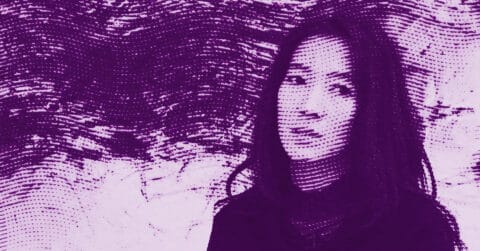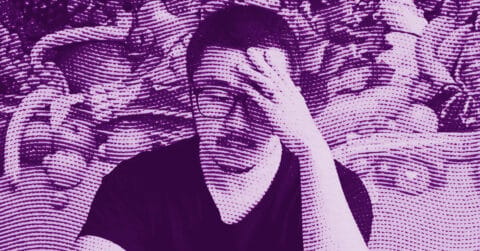Listen to me carefully, you bunch of snobs. I know you think you know everything about contemporary art with your obscure theories and your openings where organic wine costs more than the artworks on display. But today, I’m going to tell you about Loie Hollowell, born in 1983, an artist who shatters your neat little categories to create something truly revolutionary.
While our contemporary art scene worships concept at the expense of sensation, favoring convoluted explanations over visceral experiences, Hollowell dares to do exactly the opposite. Her monumental paintings, with their sculpted reliefs and hypnotic color gradients, plunge us into a universe where the female body becomes cosmos. Make no mistake: this is not simply another geometric abstraction in the saturated landscape of contemporary art. Hollowell creates an entirely new visual language, where every shape, every color pulses to the rhythm of the most intimate experience of femininity.
Take her recent series “Split Orbs” from 2021. These imposing works, with their twin spheres crossed by lines of luminous force, represent far more than a mere formal exploration. They embody a profound meditation on the duality of bodily existence, particularly in the context of motherhood. Where many artists would settle for a literal representation or cold abstraction, Hollowell offers us a transcendent experience that appeals to all our senses.
It was Edmund Burke who wrote in the 18th century about the sublime as an experience that surpasses us and terrifies us while irresistibly attracting us. Hollowell actualizes this notion by creating works that confront us with the primordial power of the female body, this force capable of creating life but also of confronting us with our own mortality. In her paintings, a simple circle is never just a circle; it becomes, in turn, a nurturing breast, a forming planet, a portal to another dimension of experience.
Her formal vocabulary is exceptionally rich. The mandorlas, those almond shapes that evoke both the vulva and the sacred halo of medieval religious art, become under her brush ambiguous symbols that transcend the simple dichotomy between sacred and profane. The ogives, borrowed from Gothic architecture, transform into breasts full of milk or mystical mountains. Each form is charged with a multiplicity of meanings that enrich each other.
Light plays a major role in her work, and not just as a pictorial effect. Through her subtle gradients and relief surfaces, Hollowell creates works that seem to generate their own inner luminosity. It was Friedrich Wilhelm Schelling who spoke of light as a manifestation of the absolute in the material world. Hollowell’s paintings embody this idea by transforming light into an almost tactile presence that simultaneously reveals and transcends the materiality of the body.
Her use of color is particularly sophisticated. Celestial blues blend into flesh pinks that explode into blood reds, creating a chromatic choreography that evokes the ebb and flow of bodily sensations. In “Dilation Stage” (2024), her most recent series, each color variation corresponds to a different stage of childbirth, transforming the physical experience into a visual symphony of rare intensity.
What truly distinguishes Hollowell from her contemporaries is that she maintains a perfect balance between abstraction and figuration. Her works can simultaneously evoke a vulva and a northern lights display, a nursing breast and a solar eclipse. This ambivalence is not a gratuitous play but a sophisticated strategy to make us reflect on our relationship to the body, particularly the female body that our society tends either to hypersexualize or to render invisible.
The influence of the Californian Light and Space movement is evident in her work, notably in her way of treating light as a malleable substance. But where artists like Robert Irwin explored the limits of pure perception, Hollowell anchors her luminous explorations in the most concrete bodily experience. Her works remind us that all perception, even the most abstract, necessarily passes through the filter of the body.
Her technique is as remarkable as her formal vocabulary. Hollowell constructs her paintings like sculptures, adding layers of high-density foam and resin to create reliefs that capture and reflect light in a complex way. This tactile dimension is essential to her artistic project. The shadows cast by these reliefs are not mere decorative effects but integral parts of the work, creating a luminous choreography that changes according to the viewer’s position. With these materials, Hollowell gives physical presence to experiences often considered ineffable. The surfaces of her paintings become sensitive topographies that invite both touch and sight.
Maurice Merleau-Ponty, in his Phenomenology of Perception, spoke of the body not as a mere object in space but as the very medium of our being-in-the-world. Hollowell materializes this philosophical idea by creating works that literally make us feel the sensations they evoke within our own bodies. Looking at her paintings becomes an embodied experience where vision activates all our other senses.
Her systematic use of symmetry is not merely an aesthetic choice. It is a philosophical statement about the precarious balance between order and chaos, between control and surrender, which characterizes the bodily experience. In her works on childbirth, this symmetry becomes a powerful metaphor for the birth process itself, a moment when the body literally divides into two distinct entities while maintaining a fundamental unity.
The temporal dimension is also important in her work. In her “Around the Clock” (2022) series, she transforms the daily cycle of breastfeeding into a visual meditation on the cyclic time of the maternal body. The breasts, arranged like the hours on a clock, become markers of a time that is no longer linear but organic, paced by the needs of the infant rather than social conventions.
The influence of tantric art is evident in her work, but Hollowell does not simply reproduce traditional forms. She reinvents them in a contemporary context, creating a fascinating dialogue between Eastern spirituality and Western bodily experience. Her works suggest that the sacred is not to be found in a mystical beyond but in the immediate experience of the body.
What is particularly remarkable in her recent work is the way she approaches the experience of childbirth. In an artistic tradition that has largely avoided this subject or relegated it to the margins, Hollowell places it at the center of her practice. Her depictions of cervical dilation transform this physiological process into a cosmic epic where the maternal body becomes the site of a universal transformation.
The political dimension of her work should not be underestimated. In a context where reproductive rights are constantly threatened, where the female body remains an ideological battlefield, Hollowell’s works affirm the power and autonomy of the female body. Her work on abortion, notably in “Emerald Mountain” (2013), approaches this experience not as trauma but as a moment of liberation and self-affirmation.
There is a deeply Spinozist dimension in her work. For Baruch Spinoza, body and mind were only two aspects of the same substance, and joy was linked to the increase of our power to act. Hollowell’s works embody this philosophy by celebrating the power of the female body without ever reducing it to its mere materiality. Each painting is an affirmation of the joy that can emerge even from the most intense physical experiences.
Her treatment of sexuality is particularly nuanced. Unlike so many artists who unconsciously reproduce the male gaze, Hollowell creates works that celebrate female desire in all its complexity. Her “Linked Lingams” are not mere phallic representations but sophisticated explorations of the interconnection of sexual energies.
In her most recent works, Hollowell pushes her exploration of corporality even further by incorporating direct casts of pregnant women’s bodies. These sculptural elements create a fascinating bridge between abstraction and physical reality, between artistic representation and direct bodily presence. It’s a bold evolution that reaffirms her commitment to grounding her work in lived experience while maintaining a transcendent dimension.
Hollowell’s color palette has also enriched over the years. To the flesh tones and celestial blues of her early works have been added bile greens, twilight mauves, electric fuchsias that expand the emotional spectrum of her work. Each color is calibrated not only for its visual value but for its ability to evoke a specific physical sensation.
What makes her work particularly relevant today is that she creates pieces that resist digital reproduction. In a world where art is increasingly consumed through screens, Hollowell’s paintings demand physical presence. The play of shadow and light, subtle reliefs, texture variations can only be fully appreciated in person, reminding us of the importance of direct experience in an increasingly mediated world.
Loie Hollowell’s work represents far more than a mere formal innovation in the field of geometric abstraction. It is a bold attempt to create a new visual language capable of expressing the ineffable, those moments when our bodily experience becomes so intense that it transcends the limits of conventional representation. In an artistic landscape often dominated by cynicism and intellectual distance, her work reminds us that art can still touch us at the deepest level, making us feel in our flesh the transformative power of aesthetic experience.
And you know what? If this makes you uncomfortable, if these bodies transformed into cosmos disturb you, if this unashamed celebration of female corporality unsettles you, it may be exactly what contemporary art needs. In a world constantly trying to disembody us, to make us forget our bodily condition, Hollowell’s work is a monumental reminder of our fundamental humanity, in all its terrible and sublime beauty.
















